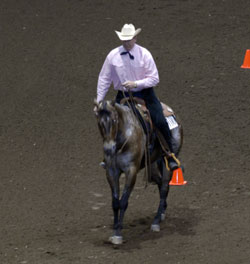 I’m here in Oklahoma City and the National Appaloosa Horse Show is in full swing on Independence Day. This is one big show that takes place over a couple weeks since it’s combined with the World Championship Appaloosa Youth Show. I’m just going to be spending a couple days here at the end.
I’m here in Oklahoma City and the National Appaloosa Horse Show is in full swing on Independence Day. This is one big show that takes place over a couple weeks since it’s combined with the World Championship Appaloosa Youth Show. I’m just going to be spending a couple days here at the end.
One of the main reasons I’m here is to post content onto Appaloosa Blog Spot, the blog of the Appaloosa Horse Club. In part I’m doing it to show a way they can use the mechanism we built for them for events like this one. The organization has others throughout the year. I’ll be taking pictures, doing interviews and cross posting here and on their site.
Now, I’ll admit up front that I’m not “horsey” as some people like to call it. It’s not that I’ve never ridden a horse. I have many times but it’s going to be a challenge to talk the lingo. I’ll let you be the judge of how I do.
Of course all my photos from the event are being placed online in a photo album. Be sure to check it out. Shooting a moving target inside from long distance under some less than ideal lighting is a challenge. Hopefully I’ll learn how to handle it.
2007 National Appaloosa Horse Show Photo Album

 I don’t know about you but I think it’s time to relax and start celebrating our Independence Day.
I don’t know about you but I think it’s time to relax and start celebrating our Independence Day. I’ll be doing my holiday grilling this evening since I’ll be in Oklahoma City tomorrow.
I’ll be doing my holiday grilling this evening since I’ll be in Oklahoma City tomorrow. Here’s an example of how you can use a MySpace page. It’s called the
Here’s an example of how you can use a MySpace page. It’s called the  Garfield the cat is now an FFA spokesperson or rather cat. Find him on Garfield’s Middle School Discovery.
Garfield the cat is now an FFA spokesperson or rather cat. Find him on Garfield’s Middle School Discovery. I think this is one of those lazy kind of weeks. We’ve got a national holiday in the middle of it! Either you’re getting ready for it or you’ll be recovering from it afterward. But some of us are working at it. One of those people is Jenny Pickett, Chief Operating Officer for the
I think this is one of those lazy kind of weeks. We’ve got a national holiday in the middle of it! Either you’re getting ready for it or you’ll be recovering from it afterward. But some of us are working at it. One of those people is Jenny Pickett, Chief Operating Officer for the 
 I have a niece who would probably love to go to this show which is taking place right now in Oklahoma City. I emailed her yesterday that she will be able to see a lot of what’s going on here on AgWired later this week. I’ll be covering activities there starting Wednesday. Yep. Independence Day. I guess it’s because the
I have a niece who would probably love to go to this show which is taking place right now in Oklahoma City. I emailed her yesterday that she will be able to see a lot of what’s going on here on AgWired later this week. I’ll be covering activities there starting Wednesday. Yep. Independence Day. I guess it’s because the  Have you ever tried
Have you ever tried